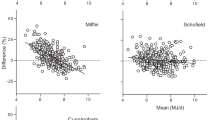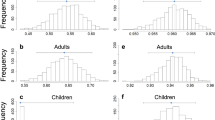Abstract
Objective:
To determine whether the age-related decrease in resting energy expenditure (REE) is explained by variations in body composition.
Design:
In Study 1, adult subjects (20–70 years) from the Québec Family Study were classified into five different age groups. Body composition was measured by hydrodensitometry to determine fat mass and fat-free mass as predictors of REE. In the youngest group of individuals these predictors were used to plot a reference regression that was then used to predict REE in the other age groups. In Study 2, this issue was investigated in a longitudinal design (6-year follow-up). Subjects were subdivided into three groups and a reference regression was plotted at the beginning of the follow-up and was then used to predict REE 6 years later in the three age groups.
Subjects:
In Study 1, 627 adults (288 men and 339 women), aged between 20 and 70 years. In Study 2, 191 adults (93 men and 98 women).
Results:
In Study 1, measured REE was 329, 302, 528 and 636 kJ/day (P<0.0001) below predicted REE at 34, 44, 54 and 64 years, respectively. In Study 2 the most marked deviation from predicted REE in response to the 6-year follow-up in men was observed in young adults (−548 kJ/day, P<0.001) while in women, the largest deviation occurred later in life (−720 kJ/day, P<0.001).
Conclusion:
Aging is accompanied by a decrease in REE that is significantly greater than what is predicted by variations in body composition. This decrease may reach a mean level of about 500–800 kJ/day.
This is a preview of subscription content, access via your institution
Access options
Subscribe to this journal
Receive 12 print issues and online access
$259.00 per year
only $21.58 per issue
Buy this article
- Purchase on Springer Link
- Instant access to full article PDF
Prices may be subject to local taxes which are calculated during checkout


Similar content being viewed by others
References
Applegate WB (1992). High blood pressure treatment in the elderly. Clin Geriatr Med 8, 103–117.
Behnke AR, Wilmore JH (1974). Evaluation and Regulation of Body Build and Composition. Englewood Cliffs, NJ: Prentice-Hall. pp. 20–37.
Bosy-Westphal A, Eichhorn C, Kutzner D, Illner K, Heller M, Muller MJ (2003). The age-related decline in resting energy expenditure in humans is due to the loss of fat-free mass and to alterations in its metabolically active components. J Nutr 133 (7), 2356–2362.
Bouchard C (1996). Genetic epidemiology, association, and sib-pair linkage: Results from the Québec Family Study. In: Bray GA, Ryan DH (eds.), Molecular and Genetic Aspects of Obesity. Baton Rouge, LA: Louisiana State University Press. pp. 470–481.
Bouchard C, Tremblay A, Leblanc C, Lortie G, Savard R, Thériault G (1983). A method to assess energy expenditure in children and adults. Am J Clin Nutr 37, 461–467.
Canada HW (1991). The Canadian Nutrient File. Government of Canada.
Chumlea WC, Baumgartner RN, Garry PJ, Rhyne RL, Nicholson C, Wayne S (1992). Fat distribution and blood lipids in a sample of healthy elderly people. Int J Obes Relat Metab Disord 16, 125–133.
Conway JM, Seale JL, Jacobs DRJ, Irwin ML, Ainsworth BE (2002). Comparison of energy expenditure estimates from doubly labeled water, a physical activity questionnaire, and physical activity records. Am J Clin Nutr 75, 519–525.
Doucet E, St-Pierre S, Almeras N, Despres JP, Bouchard C, Tremblay A (2001). Evidence for the existence of adaptive thermogenesis during weight loss. Br J Nutr 85, 715–723.
Evans WJ, Campbell WW (1993). Sarcopenia and age-related changes in body composition and functional capacity. J Nutr 123, 465–468.
FAO/WHO/UNU (1985). Energy and Protein Requirements Report of a Joint Expert Consultatiion. WHO Technical Report Series, no 724 Geneve: WHO.
Gallagher D, Visser M, Wang Z, Harris T, Pierson RNJ, Heymsfield SB (1996). Metabolically active component of fat-free body mass: influences of age, adiposity, and gender. Metabolism 45, 992–997.
Gallagher D, Allen A, Wang Z, Heymsfield SB, Krasnow N (2000). Smaller organ tissue mass in the elderly fails to explain lower resting metabolic rate. Ann NY Acad Sci 904, 449–455.
Horber FF, Gruber B, Thomi F, Jensen EX, Jaeger P (1997). Effect of sex and age on bone mass, body composition and fuel metabolism in humans. Nutrition 13, 524–534.
Hunter GR, Weinsier RL, Gower BA, Wetzstein C (2001). Age-related decrease in resting energy expenditure in sedentary white women: effects of regional differences in lean and fat mass. Am J Clin Nutr 73, 333–337.
Kahn SE, Schwartz RS, Porte Jr D, Abrass IB (1991). The glucose intolerance of aging. Implications for intervention. Hosp Pract (Off Ed) 26, 29–38.
Katzel LI, Busby-Whitehead MJ, Goldberg AP (1993). Adverse effects of abdominal obesity on lipoprotein lipids in healthy older men. Exp Gerontol 28, 411–420.
Kerckhoffs DA, Blaak EE, Van Baak MA, Saris WH (1998). Effect of aging on beta-adrenergically mediated thermogenesis in men. Am J Physiol 274, E1075–1079.
Krems C, Luhrmann PM, Strassburg A, Hartmann B, Neuhauser-Berthold M (2005). Lower resting metabolic rate in the elderly may not be entirely due to changes in body composition. Eur J Clin Nutr 59 (2), 55–62.
Leibel RL, Rosenbaum M, Hirsch J (1995). Changes in energy expenditure resulting from altered body weight. N Engl J Med 332, 621–628.
Lührmann PM, Heber BM, Krems C, Neuhäuser-Berthold M (2002). a new equation especially developed for predicting resting metabolic rate in the elderly for easy use in practice. Eur J Nutr 41, 108–113.
Meneely EA, Kaltreider NL (1949). Volume of the lung determined by helium dilution. J Clin Invest 28, 129–139.
Piers LS, Soares MJ, McCormack LM, O’Dea K (1998). Is there evidence for an age-related reduction in metabolic rate? J Appl Physiol 85, 2196–2204.
Poehlman ET (1993). Regulation of energy expenditure in aging humans. J Am Geriatr Soc 41, 552–559.
Poehlman ET, Horton ES (1990). Regulation of energy expenditure in aging humans. Ann Rev Nutr 10, 255–275.
Poehlman ET, Gardner AW, Goran MI (1992). Influence of endurance training on energy intake, norepinephrine kinetics, and metabolic rate in older individuals. Metabolism 41, 941–948.
Ravussin E, Lillioja S, Anderson TE, Christin L, Bogardus C (1986). Determinants of 24-h energy expenditure in man. Methods and results using a respiratory chamber. J Clin Invest 78, 1568–1578.
Roberts SB, Fuss P, Heyman MB, Young VR (1995). Influence of age on energy requirements. Am J Clin Nutr 62, 1053S–1058S.
Roubenoff R (2000). Sarcopenia and its implications for the elderly. Eur J Clin Nutr 54 (Suppl 3), S40–S47.
Roubenoff R, Hughes VA (2000). Sarcopenia: current concepts. J Gerontol A Biol Sci Med Sci 55, M716–M724.
Rudman D (1985). Growth hormone, body composition, and aging. J Am Geriatr Soc 33, 800–807.
Saris WH (1995). Effects of energy restriction and exercise on the sympathetic nervous system. Int J Obes 19 (Suppl 7), S17–S23.
Shimokata H, Tobin JD, Muller DC, Elahi D, Coon PJ, Andres R (1989). Studies in the distribution of body fat: I. Effects of age, sex, and obesity. J Gerontol 44, M66–M73.
Siri WE (1956). The gross composition of the body. Adv Biol Med Physiol 4, 239–280.
Tremblay A, Sévigny J, Leblanc C, Bouchard C (1983). The reproducibility of a three-day dietary record. Nutri Res 3, 819–830.
Tremblay A, Drapeau V, Doucet E, Almeras N, Despres J-P, Bouchard C (1998). Fat balance and ageing: results from the Quebec Family Study. Br J Nutr 79, 413–418.
Vaughan L, Zurlo F, Ravussin E (1991). Aging and energy expenditure. Am J Clin Nutr 53, 821–825.
Weir JB (1949). New methods for calculating metabolic rate with special reference to protein metabolism. J Physiol 109, 1–9.
Zamboni M, Armellini F, Milani MP, De Marchi M, Todesco T, Robbi R et al. (1992). Body fat distribution in pre- and post-menopausal women: metabolic and anthropometric variables and their inter-relationships. Int J Obes 16, 495–504.
Acknowledgements
This research was supported by grants from the Canadian Institutes for Health Research C Bouchard is partly supported by the George A Bray chair in Nutrition. A Tremblay is partly funded by the Canada Research Chair in Physical Activity, Nutrition and Energy Balance.
Author information
Authors and Affiliations
Corresponding author
Additional information
Guarantor: A Tremblay.
Contributors: GA-G and ED were responsible for writing the manuscript and data collection and analysis. They also reviewed relevant literature, interpreted data, and drafted the manuscript. CB and AT were responsible for the study design. They contributed to the manuscript preparation and revised the manuscript before publication.
Rights and permissions
About this article
Cite this article
Alfonzo-González, G., Doucet, E., Bouchard, C. et al. Greater than predicted decrease in resting energy expenditure with age: cross-sectional and longitudinal evidence. Eur J Clin Nutr 60, 18–24 (2006). https://doi.org/10.1038/sj.ejcn.1602262
Received:
Revised:
Accepted:
Published:
Issue Date:
DOI: https://doi.org/10.1038/sj.ejcn.1602262
Keywords
This article is cited by
-
Effects of acute exercise on spontaneous physical activity in mice at different ages
BMC Sports Science, Medicine and Rehabilitation (2021)
-
The impact of multimorbidity on resting metabolic rate in community-dwelling women over a ten-year period: A cross-sectional and longitudinal study
The journal of nutrition, health & aging (2017)
-
Effects of the menopausal transition on energy expenditure: a MONET Group Study
European Journal of Clinical Nutrition (2013)
-
Changes in resting metabolic rate in an elderly German population: Cross-sectional and longitudinal data
The journal of nutrition, health & aging (2010)



